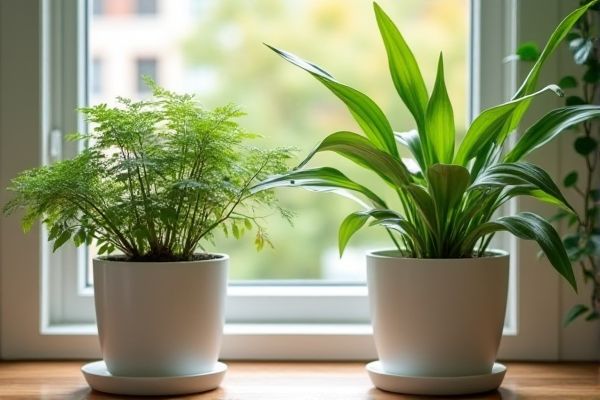
Self-watering planters maintain consistent moisture levels by providing water directly to plant roots, reducing the frequency of watering compared to regular planters that require manual irrigation. Discover how choosing the right planter can enhance your gardening experience and meet your specific plant care needs by reading the full article.
Table of Comparison
| Feature | Self Watering Planter | Regular Planter |
|---|---|---|
| Watering Frequency | Less frequent; water reservoir provides consistent moisture | Requires daily or frequent manual watering |
| Plant Health | Promotes steady root hydration, reducing over or under watering | Higher risk of inconsistent moisture levels affecting growth |
| Maintenance | Lower maintenance due to automated watering system | Higher maintenance; requires regular monitoring |
| Cost | Generally higher initial investment | Usually more affordable upfront |
| Setup Complexity | Requires reservoir filling and setup | Simple soil and plant setup |
| Ideal For | Busy gardeners, indoor plants, drought-prone areas | Experienced gardeners, outdoor plants, controlled watering |
Introduction to Self Watering and Regular Planters
Self-watering planters incorporate a built-in reservoir that supplies water directly to plant roots, ensuring consistent moisture levels and reducing the frequency of manual watering. Regular planters require routine watering from the user, relying on the soil's surface moisture and drainage to maintain plant health. The self-watering system enhances plant growth efficiency by minimizing water stress, while regular planters offer more control over watering but demand more attention and monitoring.
How Self Watering Planters Work
Self-watering planters use a reservoir at the base to store water, allowing plants to absorb moisture through capillary action or wicking. This design maintains consistent soil hydration by controlling water release, reducing overwatering and promoting healthy root growth. Unlike regular planters, they minimize the need for frequent watering, making them ideal for busy gardeners or indoor environments.
Traditional Planters Explained
Traditional planters rely on manual watering, requiring consistent attention to soil moisture levels to prevent under or overwatering. These planters often have drainage holes to avoid waterlogging, but frequent watering schedules are necessary, especially in dry or hot climates. Choosing the right soil mix and pot size is essential to maintain healthy root systems in regular planters.
Key Differences Between Self Watering and Regular Planters
Self-watering planters feature built-in reservoirs that provide consistent moisture to plants, reducing the risk of overwatering or underwatering, unlike regular planters which rely on manual watering. These planters promote healthier root systems by maintaining optimal soil hydration levels, while regular planters require frequent watering and monitoring for soil dryness. Self-watering systems also offer water efficiency by minimizing evaporation and runoff, whereas regular planters often experience water loss and uneven moisture distribution.
Watering Efficiency and Plant Health
Self-watering planters enhance watering efficiency by providing a consistent moisture supply through a reservoir, reducing water wastage and promoting deeper root growth. Regular planters often require frequent manual watering, which can lead to uneven moisture levels and increased risk of overwatering or underwatering. The consistent hydration in self-watering planters supports healthier plants by minimizing stress and improving nutrient uptake.
Maintenance Requirements
Self-watering planters significantly reduce maintenance requirements by providing a consistent water supply through a built-in reservoir, minimizing the need for frequent watering. Regular planters demand daily or frequent manual watering and close monitoring to prevent both overwatering and underwatering, increasing the risk of plant stress. You can save time and effort with self-watering planters, ensuring your plants remain hydrated even during busy schedules or travel.
Cost Comparison
Self-watering planters generally have a higher upfront cost, ranging from $20 to $60 depending on size and brand, compared to regular planters which can be as low as $5 to $15. Over time, self-watering planters may save money on water and reduce plant replacement costs due to consistent hydration, potentially lowering overall maintenance expenses. Regular planters often require more frequent watering and monitoring, which can increase labor costs and water usage, making self-watering models more cost-effective for long-term plant care.
Ideal Plants for Each Planter Type
Self-watering planters are ideal for moisture-loving plants such as ferns, peace lilies, and African violets, which thrive with consistent hydration. Regular planters suit drought-tolerant plants like succulents, cacti, and herbs, where you control the watering frequency to prevent overwatering. Choosing the right planter type ensures your plants receive the optimal soil moisture for healthy growth.
Environmental Impact
Self-watering planters reduce water waste by delivering consistent moisture directly to plant roots, promoting efficient water use and lowering overall consumption. Regular planters often require more frequent watering, which can lead to runoff and higher water usage, negatively impacting local ecosystems. Choosing a self-watering planter can help you minimize your environmental footprint while maintaining healthy, thriving plants.
Choosing the Best Planter for Your Needs
Self-watering planters provide a consistent moisture level through built-in reservoirs, reducing the frequency of watering and minimizing the risk of over or underwatering. Regular planters require more frequent monitoring and manual watering, offering flexibility in soil types and drainage options ideal for plants with specific moisture needs. Your choice depends on your gardening routine, plant type, and how much maintenance you're willing to commit to for optimal growth.
 homyna.com
homyna.com